Hindus have tolerated Enough, Now its time to Sanction and Punish Bangladesh
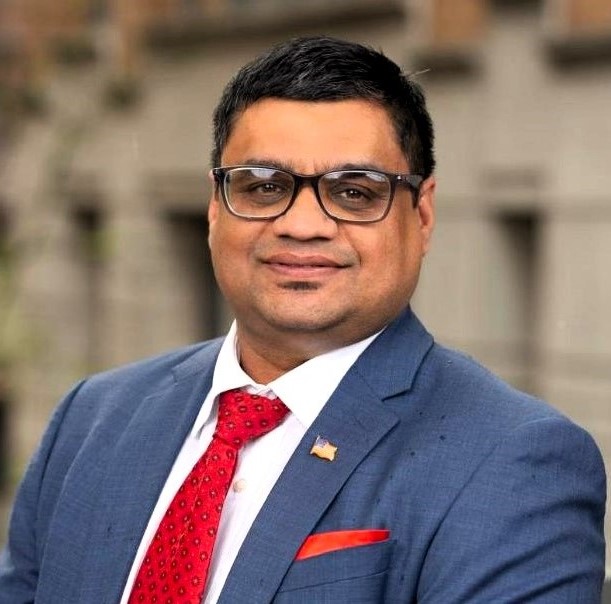
Since the start of Hamas attacks on Israel last October, we often heard the word “Holocaust”. Let’s look at what in dictionary it means.
The term “Holocaust” originates from ancient Greek, meaning “Burnt Offering”. Historians used it before World War II to describe the mass death of people. However, since 1945, it has become synonymous with the murder of European Jews during the war. This is why we use the term “Holocaust” when referring to Jewish persecution.
One may question why such a horrific event like the Holocaust occurred and how one person could act so cruelly toward another.
When we delve into human activities, we see that violence often stems from three main reasons:-
- Religious wars and conversions through brutal tortures
- Stemming from ethnic hatred, and
- Linguistic differences.
Of these three, religion and war have been intertwined throughout human history. Religious armies often go to war after prayers, firmly believing that God is on their side.
In history, it has been observed that in religious wars, the losing side is brutally forced to convert to the religion of the victor. The Indian subcontinent has witnessed such forced conversions for the past 1000 years.
Time has revealed that religious wars have three fundamental characteristics: –
- They have a fixed religious objective that persists beyond individual conflicts, as evidenced in the current situation in the Indian Subcontinent.
- The war is often endorsed by a prominent religious or spiritual leader, as seen in Afghanistan and Syria.
- There are promised tangible or spiritual rewards for combatants and those who die in battle, as evident in the global Jihad wars.
The conspicuous absence of discourse pertaining to the “Hindu Holocaust” within the annals of world history is noteworthy. From a neutral standpoint, it is conceivable that this event may be identified as the most protracted and egregious genocide in the annals of human history. Hindu genocide had started long back in the Indian subcontinent with the arrival of the Islamic invaders and later Christian evangelists from Europe (Goa Inquisition). Hindu oppression and persecution equating to no less than the Holocaust continue unabated to this day in nations such as Pakistan and Bangladesh. The most alarming fact is that this genocide is happening right under the nose of the United Nations Human Rights Council (UNHRC), countries which are the epitome of religious freedom like the USA, Canada, UK, Australia, and New Zealand and not to mention Organizations like Amnesty and every Human Right organization on earth but all preferred to remain tight-lipped.
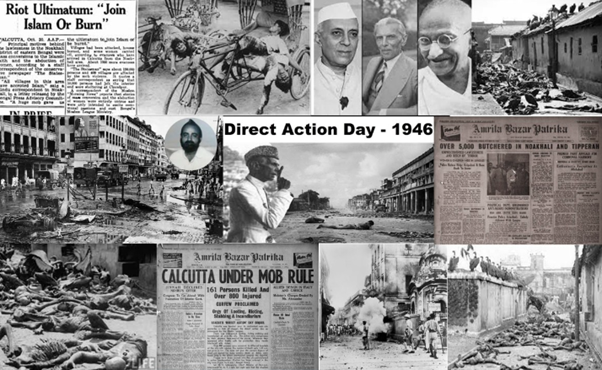
Pre-Independence Islamic Barbarism on Hindus
Hindus in Bangladesh (Indian sub-continent) have been facing annihilation since the 13th Century when foreign Islamic rule slowly made its way into the region with a completely different set of cultures and religious rivalry. What started in the 13th Century has not only continued to date but modified itself to suit the modern political framework and other administrative systems.
The Muslim League started the Pakistan movement, during the 1940s, which unleashed a reign of horror in undivided Bengal just before the 1947 India’s Partition. History tells how the extremely brutal “Calcutta Killings,” also known as the “Direct Action Day Riots” led to ghastly deaths of hundreds and thousands of innocent Hindus. This was followed by another equally terrible carnage known as the “Noakhali Riots,” where other thousands of Hindus faced uncontrolled murders, brutal rapes, lootings, evictions, and forced conversions.
Yasmin Khan, author of “The Great Partition: The Making of India and Pakistan,” highlighted the alarming rhetoric and lack of action by authorities during the Calcutta killings. The then Mayor of Calcutta, Syed Mohammed Usman, urged Muslims to take up arms in a pamphlet. The Pamphlet states “We Muslims have had the crown and have ruled. Do not lose hearts, be ready and take swords. Oh kafir! Your doom is not far”, while Bengal Chief Minister Husseyn Shahid Suhrawardy indirectly promised no consequences for armed Muslims.
DN Panigrahi, author of “India’s Partition: The Story of Imperialism in Retreat,” confirmed the inaction of police and army during the unrestrained violence, which continued for 48 hours. It is troubling that the military only intervened when the safety of Europeans was threatened, indicating collaboration between the League and the British colonial government.
The Calcutta killings incited a series of uncontrolled and strategically orchestrated communal violence incidents aimed at Hindus in various regions, including Bihar and then undivided Bengal in undivided India. Subsequently, the Noakhali killings, which ensued after the events in Calcutta, were deliberately initiated on the auspicious day of Kojagori Lakshmi puja. This precipitated more than 5,000 fatalities, numerous instances of severe sexual assault, kidnappings of women, widespread looting, and arson, spanning an area of 200 square miles for several weeks as quoted by Yasmin Khan in his book.
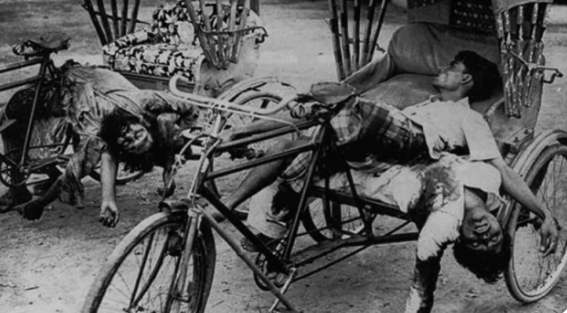
Unabated Hindu Genocide after Pakistan Creation
Pakistan, which resulted from the demands for a separate homeland by the Muslims of the Indian subcontinent, emerged in 1947 following the partition from India. East Pakistan (later Bangladesh) was initially part of Pakistan from 1947 to 1971. However, due to significant economic, cultural, ideological, communal, and linguistic disparities, particularly the imposition of Urdu in East Pakistan, a movement advocating for Bangladesh’s independence from Pakistan gained momentum.
Even after Post-Partition, the Hindu persecution and communal violence in East Pakistan (Bangladesh) did not stop and continued unabated, wherein often all members of Hindu villages would be exterminated and the women raped and mutilated before killing.
On March 25th 1971, the Pakistan Army, under President Yahya Khan’s ordered “Operation Searchlight[1]”, unleashed a campaign of terror that persisted until its final surrender to the Indian Army on December 17th 1971. This brutal campaign and terror unleashed by the Pakistan Army resulted in an estimated 10 million Bangladeshi refugees seeking safety in India, as revealed in Senator Edward Kennedy’s report to the US Senate Judiciary Committee.
Additionally, various humanitarian agencies and the Bangladesh government’s official estimate indicate a staggering three million lives lost. It is important to note that among the 10 million refugees, who escaped to India were Hindus as per Kennedy’s report.
In a report dated 1st November 1971, Senator Edward Kennedy detailed the extensive evidence documenting the reign of terror in East Bengal (East Pakistan). Senator Edward Kennedy stated, “The report cited field reports to the US Government, numerous eyewitness journalistic accounts, and reports from international agencies such as the World Bank.
One of the most affected groups has been the Hindu community, who have faced systematic slaughters, property confiscation, and inhumane treatment, including being marked with yellow patches bearing the letter “H“. All these atrocities have been officially sanctioned and implemented under martial law from Islamabad[2].
Sydney Schanberg, a reputed and brave journalist from the New York Times, fearlessly reported from Dhaka in 1971, bringing to light the atrocities committed by the Pakistani Army and documenting the struggle for Bangladesh’s independence. He wrote a column in NYT titled “The Pakistani Slaughter That Nixon Ignored”, where he stated “I covered the war and witnessed first the population’s joyous welcome of the Indian soldiers as liberators… Later I toured the country by road to see the Pakistani legacy first-hand. In town after town there was an execution area where people had been killed by bayonet, bullet and bludgeon. In some towns, executions were held on a daily basis…. human bones were still scattered along many roadsides. Blood stained clothing and tufts of human hair clung to the brush at these killing grounds. Children too young to understand were playing grotesque games with skulls. Other reminders were the yellow ‘H’s the Pakistanis had painted on the homes of Hindus, particular targets of the Muslim army.” This was after the war had ended.
Approximately 2.4 million Bengali Hindus lost their lives during the 1971 Bangladesh war of independence. Shockingly, more than half of the women were subjected to horrific acts of rape by the Pakistani Army, with the majority of these cases going unreported.
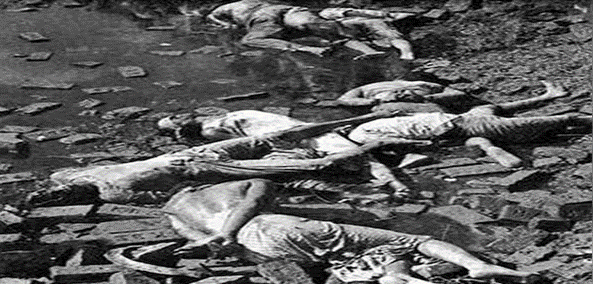
Communal violence and Religious Intimidation in Bangladesh
Since partition in 1947, the Hindus of Bangladesh have been living as second-class citizenship, first under the Islamic theocracy of Pakistan until 1971, and subsequently under various governments in Bangladesh where leadership positions were exclusively reserved for Muslims. This exclusionary practice persisted even after Bangladesh gained independence in 1971. Although secularism was initially incorporated as one of the fundamental governing principles in the 1972 Constitution of Bangladesh by Sheikh Mujibur Rehman, this commitment was short-lived. In 1975, a military coup deposed Sheikh Mujibur Rehman in the name of the “Islamic Republic of Bangladesh”.
General Ziaur Rahman strengthened the religious foundation of the Constitution by removing “secularism” as one of the four major fundamental principles of state policy and adding an Islamic invocation above the preamble through the 5th Amendment in 1979. Subsequently, General Ershad established Islam as the state religion by introducing Article 2A, which stated that “The state religion of the Republic is Islam but other religions may be practiced in peace and harmony in the Republic” through the 8th Amendment in 1988.
These changes failed to halt communal violence, but rather fuelled on-going attacks on Hindus in Bangladesh, which have persisted since 1971 and still endures to this day.
The secondary status of Hindus as ordained by their Constitution makes them vulnerable to mob violence orchestrated by fundamentalist groups, especially during election periods and times of social unrest.
In 2001, after the Bangladesh National Party (BNP), led by Khaleda Zia, won the elections, her supporters carried out a systematic campaign of genocide acts against Hindus that lasted for about 150 days. A judicial commission investigating this violence documented around 18,000 incidents of major crimes, including approximately 1,000 cases of rape against Hindu women, with 200 victims of gang rape. This led to nearly 500,000 Hindus fleeing to India for safety.
In 2013, the International Crimes Tribunal charged several Jamaat (radical) members with war crimes against Hindus during the 1971 Bangladesh atrocities. In retaliation, their supporters launched attacks on Hindus, resulting in the looting of properties and businesses, abduction and rape of women, and desecration of temples. Over 50 Hindu temples were destroyed, and more than 1,500 Hindu homes were burned across 20 districts. This highlights the urgent need to address and prevent such atrocities.
Here’s the complete Chronology of Hindus Atrocities for first 35 years till 2006 after Bangladesh Creation[3].
Hindu priests are regularly targeted and intimidated for preaching Hinduism. In February 2016, Jogeshwar Roy, a 55-year-old Hindu priest was beheaded by Islamic militants[4], while preparing for prayers inside the Deviganj temple in Panchagarh district.
It’s no doubt that Bangladesh has become the Auschwitz Centre for Hindus. Everyday Hindus are being attacked by Jamaat-e-Islami radical members. Radicals had also used Social media to organize systematic communal violence against Hindus.
On October 29th, 2016, “An Islamic group in Nasirnagar organized a protest against a Facebook post it found offensive. The post included an image of the Hindu god Shiva appearing at a Muslim holy site in the Saudi city of Mecca”.
On October 30th, 2016, hundreds of Muslims entered a Hindu neighborhood, where they ransacked 15 temples and the homes of more than 100 families. The mob “used long, hard sticks and locally made sharp weapons” to assault Hindus they found there and that at least 20 people, including a priest, were wounded[5].
Bangladesh Travail Pogrom for Hindus
As in Pakistan, Hindu minorities are being highly oppressed at the hands of Islamic forces in the Islamic state of Bangladesh. Not even a day passes by when Hindus don’t live under the constant fear of being attacked by militants of Jammat-e Islami sponsored by terror state Pakistan.
Everyday an attack on Hindus has been witnessed in terror state Bangladesh[6].
The student-led protests in Bangladesh against the reservation quota in schools and employment have evolved into a movement that resulted in the removal of Prime Minister Sheikh Hasina.
However, what initially began as a student-led “liberation movement” in Bangladesh, is now at risk of losing its credibility in the eyes of the world. It seems that the movement has been influenced and taken over by Islamist fundamentalists, who are using the resulting chaos, disorder, and lack of governance to carry out a genocidal campaign against the minority Hindu population.
Already concerns were raised over the movement’s legitimacy as it appears to have been co-opted by Islamist fundamentalists. This has led to widespread chaos and lawlessness, creating an environment in which the minority Hindu population has faced genocidal attacks.
Following the prime minister’s departure, a power vacuum which had emerged in Bangladesh, leading to reports of serious atrocities against the Hindu minority, whose numbers have dwindled significantly over the years?
In addition to the almost 300 people killed during the government crackdown, at least 60 were killed in the violence that erupted on August 5th in Muslim-majority Bangladesh[7].
Prionthi Chatterjee, a Hindu student in Dhaka, the capital, said Muslims had attacked her family at their home in the southern Bagerhat region, killing her father and leaving her mother with head injuries.
“My father was an innocent teacher,” she said in a phone interview, adding that her parents tried to call the army and the police for help but that no one responded.
The Bangladesh Hindu Buddhist Christian Unity Council (BHBCUC) said 200-300 mainly Hindu homes and businesses had been vandalized since August 5th, and 15-20 Hindu temples damaged. Up to 40 people have been injured though not seriously, its general secretary, Rana Dasgupta, told Reuters.
“The situation is horrific,” said Manindra Kumar Nath, a Hindu community leader. “Even today, we are getting calls from people asking us to save their lives, but we are not receiving any support from anywhere”[8].
The scenes of violence in 1971, especially against Hindus, and their desperation, evoked terrible memories for many who had seen the humanitarian crisis unfold. All media including Social media was flooded with several videos and reports of temples being set on fire and houses and businesses of Hindus being attacked in at least 27 districts.”
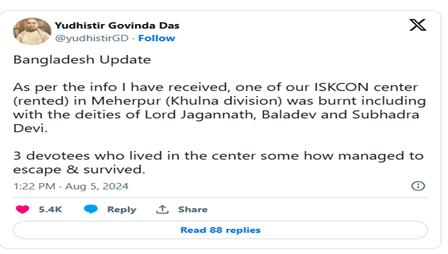
On August 8, India’s Border Security Force (BSF) thwarted “significant” attempts by a large group of Bangladeshi nationals from entering into West Bengal along the international border. “These gatherings were prompted by fears of attacks by protestors within Bangladesh,” the BSF said[9].
No Hindus left in Bangladesh in 30 years
The significant drop in the Hindu population in Bangladesh is a somber testament to the continued communal persecution.
The consistent decline in the percentage of Bangladeshi Hindus, as demonstrated by census figures, unequivocally indicates the persecution endured by Hindus in the anti-Hindu hostile environment prevailing in Bangladesh.
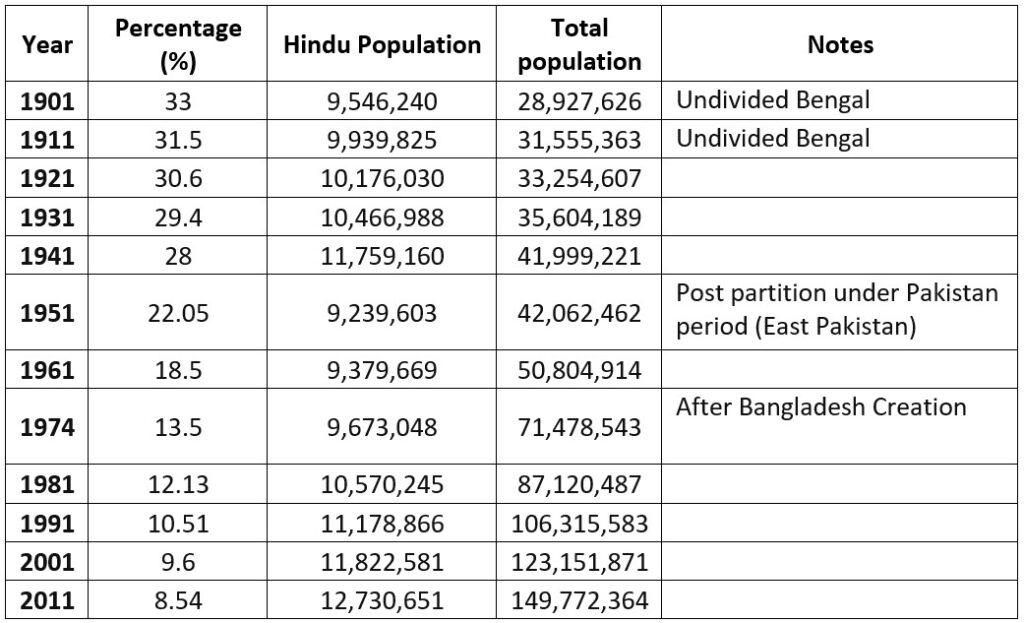
Professor Abul Barakat of Dhaka University in his book, The Political Economy of Reforming Agriculture: Land Water Bodies in Bangladesh (2016), says: “There will be no Hindus left within Bangladesh within 30 years… [as} the rate of the exodus over the past 49 years points to that direction.” Professor Barakat has found that almost 11.3 million Hindus were forced to escape from Bangladesh owing to religious persecution from 1964 to 2013.

The Hindu population has undergone a steady attrition over the years, from 28% in 1940 to 8.96% in 2011, with especially two periods of sharp decline—the first around the time of partition and the second during the 1971 Bangladesh War that resulted in the liberation of Bangladesh. However, even after the emergence of Bangladesh, the Hindu community has contracted—from 13.5% in 1974 to 8.96% in 2011—a nearly 33% decline, which is humungous in demographic terms[10].

World Responds to 2024 Bangladeshi Hindu Genocide
The recent brutal killings of hundreds of Hindus in Bangladesh have reverberated across the world, sparking widespread outrage and concern. India, as the closest neighbour, has vehemently condemned these horrific acts.
World leaders and influential bloggers have united on social media to champion the cause of protecting Bangladeshi Hindus and upholding the dignity of Muslim women.
The Indian Prime Minister took to social media to call for the safety and protection of Hindus in Bangladesh, expressing his shared concern. The Indian people and media are also outraged over these killings.

Israeli Ambassador to India, Naor Gilon raised concerns on the reports of atrocities against minorities including Hindus and their temples in Bangladesh amid intensifying protests and unrest in the country.

Multiple US politicians, such as Republican Congressmen like Texas 4th CD Patrick Fallone, Georgia 6th CD Dr. Rich McCormick, and Democrat Congressmen of Michigan 13th CD Shri Thanedar, have vehemently condemned the reported violence against Hindus in Bangladesh.
Amy Mek, a dedicated investigative journalist based in USA, is closely and vigilantly monitoring and documenting the killings of Hindus in Bangladesh Her insightful coverage on X vividly portrays the deep concerns and fears of the Hindu community.

Tommy Robinson who is an independent, corporate journalist has also questioned the United Nations for the brutal Hindus killing and rape of Hindu women in Bangladesh.

Amjad Taha, a seasoned author, analyst, and researcher specializing in Strategic Political Affairs in the Middle East, has voiced serious concerns about the killings of Hindus in Bangladesh.

Renowned YouTuber Hananya Naftali, based in Israel, has brought attention to the urgent issue of the genocide of Hindus in Bangladesh. He is urging the world to take notice, emphasizing, “At this moment, Hindus are enduring unimaginable violence, with their temples being burned, homes looted, and lives taken. This is not random violence; it is a deliberate effort to eliminate the Hindu community from their own land. Israel stands in solidarity with our Hindu brothers and sisters in their struggle against radical Islamist terror. The world cannot afford to remain silent. Immediate action is necessary to halt this modern-day genocide before it’s too late. Raise your voice and ensure that the world hears their plea for justice.”

The United Nations has unequivocally condemned the brutal attacks on Hindus in Bangladesh. The United Nations stands against any racially based attacks, Farhan Haq, deputy spokesman for the UN secretary-general, said on August 9th in response to a question on attacks on minority communities in Bangladesh.
“What we’ve made clear is we want to make sure that the violence that has been occurring in Bangladesh in recent weeks is tamped down. Certainly, we stand against any racially based attacks or racially based incitement to violence,” he said when a journalist asked about the reaction of the UN chief Antonio Guterres on the attacks on Hindus and other minorities in Bangladesh[11].
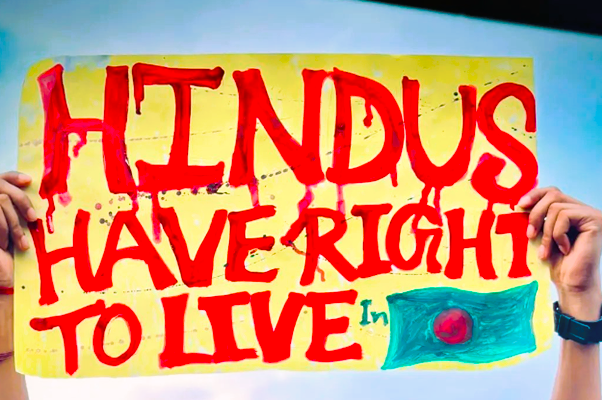
Aftermath of the orchestrated riots targeting Hindus in Bangladesh
Everyone please be aware of the repercussions of the deliberate riots aimed at Hindus in Bangladesh. The global community is closely observing the situation and taking appropriate action.
1) India :- India has successfully evacuated all non-essential staff and their families from its embassy and consulates in Bangladesh in response to the significant protests that resulted in the resignation of Prime Minister Sheikh Hasina. This proactive measure was taken following intense demonstrations over job quotas, which compelled Hasina to step down and depart the country. Despite these challenges, the Indian High Commission in Dhaka continues to operate with a limited staff, including key personnel such as the High Commissioner, who are diligently carrying out their duties. The evacuation was executed through commercial flights, ensuring the safety of the staff, while the High Commission maintains essential operations with dedicated personnel during this period of unrest.
In addition to the main embassy in Dhaka, India has assistant high commission or consulates in several other cities, including Chittagong, Rajshahi, Khulna, and Sylhet. Despite the evacuation, these posts continue to function with reduced staff[12].
2) USA :- The USA State Department has issued an advisory to its citizens who are currently in Bangladesh or planning to travel to Bangladesh. It states “Do not travel to Bangladesh due to civil unrest, crime, and terrorism”.
Country Summary: On August 5, 2024, the Department ordered the departure of non-emergency U.S. government employees and family members. Travelers should not travel to Bangladesh due to ongoing civil unrest in Dhaka. Violent clashes have occurred in the city of Dhaka, its neighboring areas, and throughout Bangladesh, and the Bangladeshi Army is deployed nationwide. Dhaka’s Hazrat Shahjalal International Airport temporarily paused operations on August 5. Travelers should check with their airlines to confirm status for future flights[13].
3) UK: – Similarly United Kingdom government has also warn its citizen who’re planning to visit Bangladesh. It states “FCDO advises against all but essential travel to Bangladesh”[14].
4) Canada: – Canada advisory states “Bangladesh – AVOID NON-ESSENTIAL TRAVEL”
Avoid non-essential travel to Bangladesh due to violent political demonstrations and clashes, and nationwide general strikes. The security situation can deteriorate without warning. Also issuing Regional risk, advisory mentions “Chittagong Hill Tracts region – Avoid all travel”. Avoid all travel to the Chittagong Hill Tracts region due to politically motivated violence, kidnappings and sporadic ethnic clashes[15].
Conclusion
In today’s world, religious conflicts have evolved into a more intricate and subtle form of warfare. This new type of warfare no longer requires physical confrontation on battlefields, but instead utilizes the clandestine depths of the internet and psychological warfare through the constant dissemination of propaganda via media and academia. The ultimate goal is to subjugate non-believers through strategic brainwashing tactics.
Of course, the “Educated Terrorists” embedded within the media and academia circles wage psychological warfare while religious foot soldiers on the ground perpetuate the bloodshed and brutalities of a medieval-era religious battlefield. At the same time, it’s very crucial for the world to remember that the fight for justice transcends boundaries. We must unite with love and compassion while also demanding action, speaking out against oppression, and ensuring that the suffering of Hindus whether it is in Pakistan or Bangladesh or any other country is not overlooked.
[1] The Forgotten Genocide: “1971 Bangladesh Hindus Genocide” – Kreately
[2] Nothing new in Hindu genocide in Bangladesh, just nature of violence has changed – Firstpost
[3] Bangladesh Hindu Genocide: The Murky World of Silence – Kreately
[4] Bangladesh Hindu priest beheaded ‘by Islamic State’ – BBC News
[5] Bangladesh: “Auschwitz Centre for Bangladeshi Hindus Genocide” – Kreately
[6] Is the World suffering from “Mute Spectator Syndrome” on Unrelenting Bangladesh Hindu Genocide? – Kreately
[7] Hindus in Bangladesh Face Revenge Attacks After Hasina’s Ouster – The New York Times (nytimes.com)
[8] Hindu homes, temples targeted in Bangladesh after Hasina ouster, minority group says | Reuters
[9] Bangladesh crisis: Blood telegrams of Hindu genocide of 1971 and how US turned blind eye – India Today
[10] There may be no Hindus left in Bangladesh in 30 years – The Sunday Guardian Live
[11] ‘UN stand against any racially based attacks’: Farhan Haq on attacks on minorities in Bangladesh | The Business Standard (tbsnews.net)
[12] Indian Embassy Staff Evacuated From Bangladesh Following Protests – TheDailyGuardian
[13] Bangladesh Travel Advisory (state.gov)





